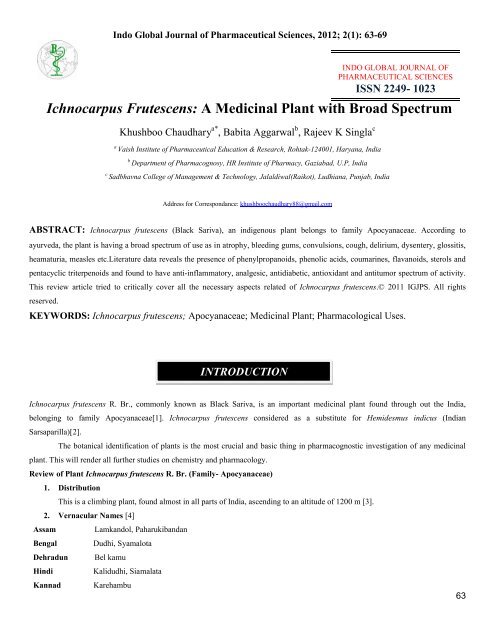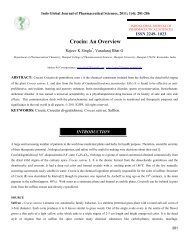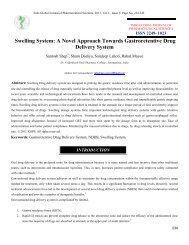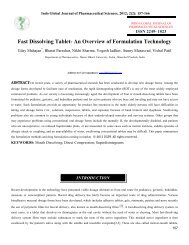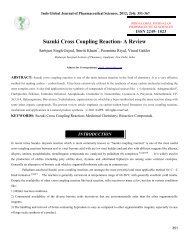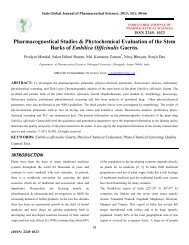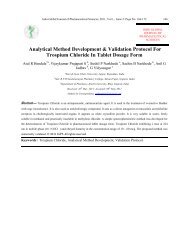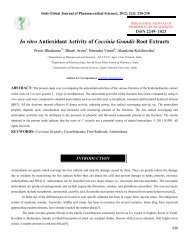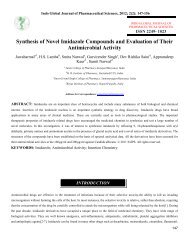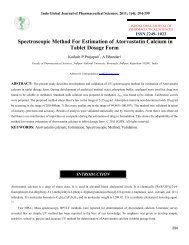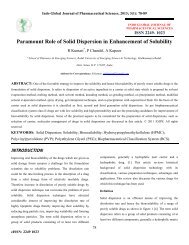Ichnocarpus Frutescens: A Medicinal Plant with ... - ResearchGate
Ichnocarpus Frutescens: A Medicinal Plant with ... - ResearchGate
Ichnocarpus Frutescens: A Medicinal Plant with ... - ResearchGate
Create successful ePaper yourself
Turn your PDF publications into a flip-book with our unique Google optimized e-Paper software.
Indo Global Journal of Pharmaceutical Sciences, 2012; 2(1): 63-69<br />
<strong>Ichnocarpus</strong> <strong>Frutescens</strong>: A <strong>Medicinal</strong> <strong>Plant</strong> <strong>with</strong> Broad Spectrum<br />
Khushboo Chaudhary a* , Babita Aggarwal b , Rajeev K Singla c<br />
a<br />
Vaish Institute of Pharmaceutical Education & Research, Rohtak-124001, Haryana, India<br />
b<br />
Department of Pharmacognosy, HR Institute of Pharmacy, Gaziabad, U.P, India<br />
c<br />
Sadbhavna College of Management & Technology, Jalaldiwal(Raikot), Ludhiana, Punjab, India<br />
INDO GLOBAL JOURNAL OF<br />
PHARMACEUTICAL SCIENCES<br />
ISSN 2249- 1023<br />
Address for Correspondance: khushboochaudhary88@gmail.com<br />
ABSTRACT: <strong>Ichnocarpus</strong> frutescens (Black Sariva), an indigenous plant belongs to family Apocyanaceae. According to<br />
ayurveda, the plant is having a broad spectrum of use as in atrophy, bleeding gums, convulsions, cough, delirium, dysentery, glossitis,<br />
heamaturia, measles etc.Literature data reveals the presence of phenylpropanoids, phenolic acids, coumarines, flavanoids, sterols and<br />
pentacyclic triterpenoids and found to have anti-inflammatory, analgesic, antidiabetic, antioxidant and antitumor spectrum of activity.<br />
This review article tried to critically cover all the necessary aspects related of <strong>Ichnocarpus</strong> frutescens.© 2011 IGJPS. All rights<br />
reserved.<br />
KEYWORDS: <strong>Ichnocarpus</strong> frutescens; Apocyanaceae; <strong>Medicinal</strong> <strong>Plant</strong>; Pharmacological Uses.<br />
INTRODUCTION<br />
<strong>Ichnocarpus</strong> frutescens R. Br., commonly known as Black Sariva, is an important medicinal plant found through out the India,<br />
belonging to family Apocyanaceae[1]. <strong>Ichnocarpus</strong> frutescens considered as a substitute for Hemidesmus indicus (Indian<br />
Sarsaparilla)[2].<br />
The botanical identification of plants is the most crucial and basic thing in pharmacognostic investigation of any medicinal<br />
plant. This will render all further studies on chemistry and pharmacology.<br />
Review of <strong>Plant</strong> <strong>Ichnocarpus</strong> frutescens R. Br. (Family- Apocyanaceae)<br />
1. Distribution<br />
This is a climbing plant, found almost in all parts of India, ascending to an altitude of 1200 m [3].<br />
2. Vernacular Names [4]<br />
Assam Lamkandol, Paharukibandan<br />
Bengal Dudhi, Syamalota<br />
Dehradun Bel kamu<br />
Hindi<br />
Kalidudhi, Siamalata<br />
Kannad Karehambu<br />
63
Malayalam<br />
Marathi<br />
Oriya<br />
Sanskrit<br />
Tamil<br />
Telugu<br />
Paalvally<br />
Indo Global Journal of Pharmaceutical Sciences, 2012; 2(1): 63-69<br />
Krishnasarwa, Kantebhouri<br />
Syamolota, Madhodi<br />
Syamlata, Sariva<br />
Udargodi<br />
Illukatte, Nalateage<br />
3. Morphology<br />
<strong>Ichnocarpus</strong> frutescens is a climbing shrub <strong>with</strong> rusty-tomentose branches. Leaves variable, opposite, elliptic-oblong or<br />
lanceolate, softly tomentose beneath, glabrous above. Flowers are purple or greenish-white, minute, borne in long terminal and<br />
axillary paniculate cymes. Fruits follicles, slender, cylindrical, curved. Seeds white <strong>with</strong> a coma [2].<br />
4. Reported Phytoconstituents<br />
Studies on chemical constituents of the plant reveals the presence of phenylpropanoids, phenolic acids, coumarines, flavanoids,<br />
sterols and pentacyclic triterpenoids i.e. Δ 12 -dehydrolupanyl-3β-palmitate, lupeol acetate, friedelin, friedelinol, Δ 12 -dehydrolupeol,<br />
oleanolic acid, nonane, 5-hydroxyoctacosan-25-one, dotriacontanoic acid, sitosterol and sitosterol palmitate [5].<br />
Stem contains α-L-rhamnopyranosyl-(1→4)-β-D-glucopyranosyl-(1→3)-α-amyrin, 6, 8, 8-trimethylpentacosan-7-one[6], α-amyrin<br />
and its acetates, lupeol and its acetates, friedelin, epi-friedelinol and β-sitosterol [7], n-butyl oleate, n-octyl tetracontane,<br />
tetratriacontadiene, n-nonadecanyl benzoate, benzocosanyl arachidate[8] .<br />
Leaves contain flavones viz. apigenin and luteolin, glycoflavones i.e. vitexin and isovitexin, proanthocyanidin and phenolic acids,<br />
vanillic, syringic and synapic acid, protocatechuic acid[9]. Ursolic acid acetate, kaemferol, kaemferol-3-galactoside (trifolin) and<br />
mannitol were also identified from leaves[10].<br />
Roots reported to consist of β-sitosterol[11] and 2-hydroxy-4-methoxybenzaldehyde[2].<br />
Flowers contain quercetin and quercetin-3-O-β-D-glucopyranoside[12].<br />
STRUCTURES OF REPORTED PHYTOCONSTITUENTS<br />
OH<br />
OH<br />
HO<br />
O<br />
OH<br />
O<br />
OH<br />
O<br />
Quercetin<br />
O<br />
Lupeol<br />
64
Indo Global Journal of Pharmaceutical Sciences, 2012; 2(1): 63-69<br />
OH<br />
OH<br />
HO<br />
O<br />
OH<br />
O<br />
O<br />
O<br />
OH<br />
H<br />
H<br />
H<br />
OH<br />
O<br />
OH<br />
OH<br />
H<br />
Quercetin-3-O-β-glucopyranoside<br />
Friedelin<br />
OH<br />
OH<br />
HO<br />
O<br />
HO<br />
O<br />
OH<br />
OH O<br />
Apigenin<br />
OH<br />
O<br />
Kaemferol<br />
OH<br />
HO<br />
OH<br />
OH<br />
O<br />
OH<br />
O<br />
HO<br />
OH<br />
O<br />
OH<br />
O<br />
HO<br />
Proanthocyanidin<br />
OH<br />
Vanillic acid<br />
65
Indo Global Journal of Pharmaceutical Sciences, 2012; 2(1): 63-69<br />
HO<br />
O<br />
O<br />
O<br />
OH<br />
HO<br />
OH<br />
O<br />
O<br />
O<br />
Syringic acid<br />
Synapic acid<br />
OH<br />
HO<br />
O<br />
Protocatechuic acid<br />
OH<br />
HO<br />
O<br />
O<br />
2-hydroxy-4-methoxybenzaldehyde<br />
OH<br />
OH<br />
HO<br />
OH<br />
O<br />
H<br />
H<br />
H<br />
OH<br />
O<br />
OH<br />
O<br />
HO<br />
OH<br />
H<br />
Vitexin<br />
Epi-friedelinol<br />
66
HO<br />
Indo Global Journal of Pharmaceutical Sciences, 2012; 2(1): 63-69<br />
HO<br />
O<br />
OH<br />
HO<br />
O<br />
OH<br />
OH<br />
OH<br />
HO<br />
O<br />
OH<br />
O<br />
OH<br />
Iso-vitexin<br />
OH<br />
O<br />
Luteolin<br />
H<br />
H<br />
OH<br />
OH<br />
H<br />
O<br />
H<br />
O<br />
HO<br />
H<br />
HO<br />
Oleanolic acid<br />
Ursolic acid<br />
HO<br />
HO<br />
H<br />
α-amyrin<br />
β-sitosterol<br />
67
Indo Global Journal of Pharmaceutical Sciences, 2012; 2(1): 63-69<br />
O<br />
Rham O Glu<br />
α-L-rhamnopyranosyl-(1→4)-β-D-glucopyranosyl-(1→3)-α-amyrin<br />
PHARMACOLOGICAL USES<br />
Leaves and roots of I. frutescens are considered to be an important drug in the indigenous system of medicine, used as a substitute for<br />
Indian Sarasparilla (Hemidesmus indicus).<br />
Chloroform and methanolic extracts of whole plant of I. frutescens are reported to posses the hepatoprotective and<br />
antioxidant activity[13].<br />
Methanolic extract of roots of I. frutescens has been reported for anti inflammatory and analgesic activities[14]. Aqueous<br />
extract of roots posses antidiabetic activity in Streptozotocin-nicotinamide induced type-II diabetes in rats[15].<br />
Hydroalcoholic extract of leaves of I. frutescens shows anti inflammatory activity[16] and also posses α-Glucosidase inhibitory and<br />
in-vitro antioxidant activities. Polyphenolic extract of leaves is reported to posses activity against tumors[17].<br />
<strong>Medicinal</strong> Uses<br />
Whole plant is used as tribal medicine in atrophy, bleeding gums, convulsions, cough, delirium, dysentery, glossitis, heamaturia,<br />
68
Indo Global Journal of Pharmaceutical Sciences, 2012; 2(1): 63-69<br />
measles, night blindness, relieves pain due to insect bites, splenomegaly and tuberculosis. <strong>Plant</strong> is also used in abdominal and<br />
glandular tumors.<br />
Roots are used as a substitute for Indian Sarasparilla (Hemidesmus indicus) as alterative, antidysentric, antipyretic,<br />
demulcent, diaphoretic, diuretic, hypoglycemic and tonic; beneficial in anorexia, leucorrhea, skin diseases, syphilis and urinary<br />
calculi.<br />
Warm leaves are applied by the tribes of Rajasthan, on the swelling to cure guinea worm infection. Decoction of leaves and<br />
stems is used in fever and skin eruption[1,2,4]<br />
REFERENCES<br />
1. The Wealth of India, A Dictionary of Indian Raw Materials and industrial products’, NISCOM, New Delhi, Vol. 3, pp. 330 (2002).<br />
2. Chatterjee A. and Pakrashi S. (2003) ‘The Treatise of Indian <strong>Medicinal</strong> <strong>Plant</strong>s’, NISCAIR, New Delhi, Vol. 4, pp. 110-112.<br />
3. <strong>Medicinal</strong> <strong>Plant</strong>s of India’, Indian Council of Medical Research, New Delhi, Vol. 2, pp. 62-64, (1987).<br />
4. Ambasta S. P. (1999) ‘Useful <strong>Plant</strong>s of India’, NISCOM, New Delhi, pp. 283.<br />
5. Verma R. K., Singh N. and Gupta M. M.(1987), ‘Triterpenoids of <strong>Ichnocarpus</strong> frutescens’, Fitoterapia, Vol. LVIII (4), pp. 271-272.<br />
6. Minchona P. K. and Tandon R. N. (1980), ‘A New Triterpene Glycoside from the Stems of <strong>Ichnocarpus</strong> frutescens’, Phytochemistry,<br />
19, pp. 2053-2055.<br />
7. Lakshmi D. K. M., Rao E. V. and Rao D. V. (1985), ‘Triterpenoid Constituents of <strong>Ichnocarpus</strong> frutescens’, Indian Drugs, 22(10), pp.<br />
552-53.<br />
8. Babita Aggarwal, Mohd Ali, Vijender Singh, Rajeev K Singla. Isolation & Characterization of Phytoconstituents from the Stems of<br />
<strong>Ichnocarpus</strong> frutescens. Chinese Journal of Natural Medicine. 2010; 8(6):0401-0404. doi: 10.3724/SP.J.1009.2010.00401<br />
9. Daniel M. and Sabnis S. D. (1978), Indian Journal of Experimental Biology, 16, pp. 512.<br />
10. Khan M. S. Y., Javed K. and Khan M. H. (1995), ‘Chemical Constituents of the Leaves of <strong>Ichnocarpus</strong> frutescens R. Br.’, Journal of<br />
Chemical Society, 72, pp. 65-66.<br />
11. Khastir H. N. and Sengupta P. (1960), ‘Investigation on <strong>Ichnocarpus</strong> frutescens R. Br.’, Journal of Applied Chemistry, 23(2), pp. 111-<br />
112.<br />
12. Singh R. P. and Singh R. P. (1987), ‘Flavanoids of the Flowers of <strong>Ichnocarpus</strong> frutescens’, Journal of Indian Chemical Society,<br />
64(11), pp. 715-716.<br />
13. Tapan K. M. et. al. (2007), ‘Evaluation of Hepatoprotective and Antioxidant Activity of <strong>Ichnocarpus</strong> frutescens (Linn.) R. Br. on<br />
Paracetamol-induced Hepatotoxicity in Rats’, Tropical Journal of Pharmaceutical Research, 6(3), pp. 755-765.<br />
14. Pandurangan A., Khosa R. L. and Hemalatha S. (2008), ‘Antiinflammatory and Analgesic Activity of <strong>Ichnocarpus</strong> frutescens’,<br />
Pharmacologyonline, 1, pp. 392-399.<br />
15. Barik R., Jain S., Qwatra D., Joshi A., Tripathi G. S. and Goyal R.(2008), ‘Antidiabetic Activity of Aqueous Root Extract of<br />
<strong>Ichnocarpus</strong> frutescens in Streptozotocin-nicotinamide Induced Type-II Diabetis in Rats’, Indian Journal of Pharmacology, 40(1), pp.<br />
19-22<br />
16. Kumarappan C. T., Rabish C. and Mandal S. C. (2006), ‘Antiinflammatory Activity of <strong>Ichnocarpus</strong> frutescens’, Pharmacologyonline,<br />
3, pp. 201-216.<br />
17. Kumarappan C. T. and Mandal S. C. (2007), ‘Antitumor Activity of Polyphenolic Extract of <strong>Ichnocarpus</strong> frutescens’, Experimental<br />
Oncology, 29(2), pp. 94-101.<br />
69


